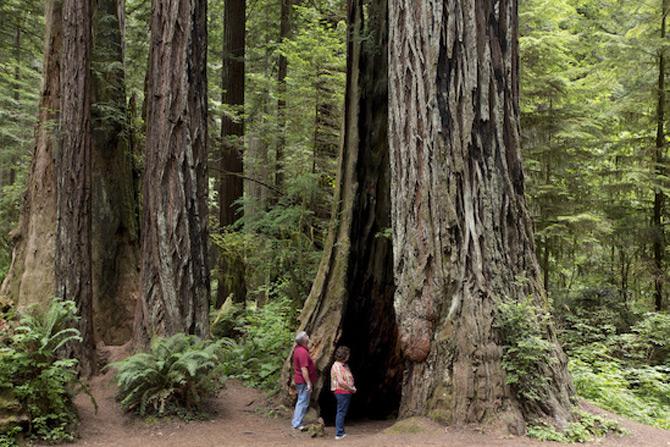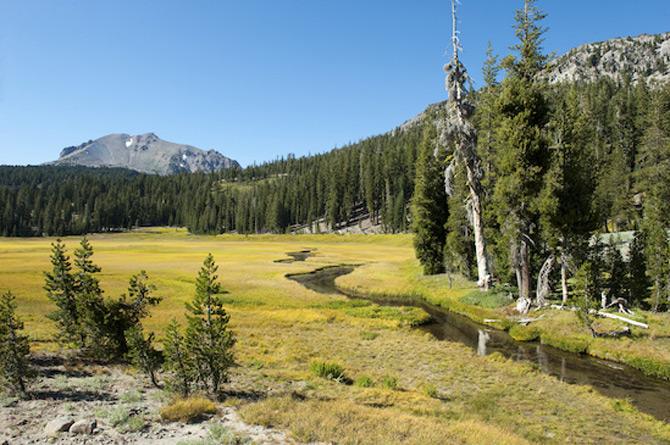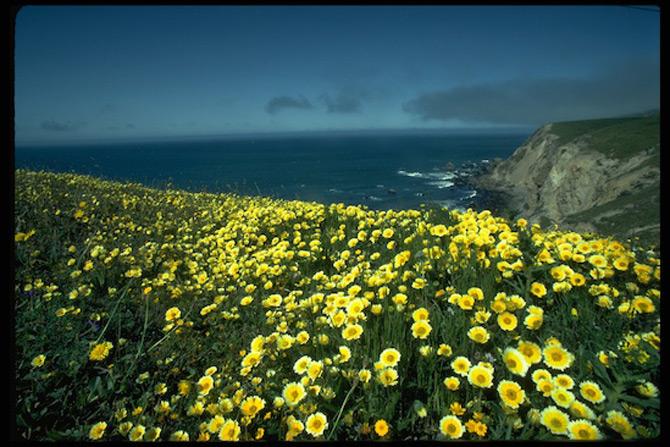When planning to visit California, don't forget to explore the wild side of the numerous National Parks located in the heart of the state

Yosemite National Park
Ask a local the best things about California, and somewhere at the top of the list would be the sheer beauty of the place. See for yourself with this dream list of incredible national parks, with smart tips and insider ideas on what to do at favourites like Yosemite and Death Valley, and some of the park system's secret (and newest) gems.
Joshua Tree National Park
Rugged mountains, vibrant sunsets & uncountable stars
ADVERTISEMENT
Boulders and buttresses, rugged mountains, gold mining ruins, desert plains dotted with the oddball trees—this is one weird place. Joshua Tree National Park, nicknamed “J-Tree” by locals, lies at an ecological crossroads, where the high Mojave Desert meets the low Colorado Desert. The result is amazing desert flora, including those wacky namesake trees (a type of yucca). Joshua Tree’s beauty shines around the clock, with vibrant sunsets melting into nights filled with uncountable stars. With more than 8,000 known climbs and 400 unique formations, it’s little wonder Joshua Tree is a dirtbag’s paradise. Echo Cove has plenty of routes great for first-timers and advanced climbers alike. BYO gear or rent everything from shoes to chalk at Ventures. Experience sunset at Keys View, the highest point in Joshua Tree, Keys View offers round-the-clock breath-taking vistas. Night-time serves up sparkling splendour; and during clear days, visitors are treated to sweeping views of the Coachella Valley, Palm Springs, and the surrounding peaks that stretch all the way to Mexico.
Yosemite National Park:
California's iconic park in the Sierra Nevada mountains
Famous for its plunging waterfalls and massive granite faces, this unparalleled parkland, designated as a UNESCO World Heritage site in 1984, attracts 4 million visitors each year—with good reason. Nearly the size of Rhode Island and covering more than 1,100 square miles/284,899 hectares, it features unforgettable natural beauty, from the sheer walls of Yosemite Valley to the alpine beauty of Tuolumne Meadows. The park has a distinct appeal no matter what time of year—here, shoulder season simply means less people and a chance to see Yosemite's beauty from a different angle. Spring brings gushing waterfalls, summer allows for tackling all outdoor pursuits, fall boasts colourful trees and fewer crowds, and winter becomes a snowy wonderland for cross-country skiing and snowshoeing.

The Redwood National and State Parks (RNSP) are located in the United States, along the coast of northern California
Redwood National Park:
A wealth of hiking, camping, and tree-ogling options
Even if you’re a pro basketball player, you can’t help feeling downright puny in this stunning preserve, where soaring redwoods line up like living skyscrapers. Start your trip at the excellent Thomas H. Kuchel Visitor Center, one mile south of Orick. Of the five visitor centers in Redwood National and State Parks, this one is the largest, with numerous exhibits and a video on redwood ecology, a great bookstore, and access to a sandy beach. Next, do a little driving. Start 5 miles/8 kilometers north of the small hamlet of Klamath at the Klamath River Overlook, where the freshwater river meets the Pacific Ocean at a huge estuary. Perched 650 feet/198 meters above the sea, this overlook point is a prime spot for watching migrating gray whales (best time is December to April). Be sure to walk the short and easy path to the lower overlook for dramatic views of crashing surf. Then head south to cruise the Coastal Drive (great for mountain biking too). This 9-mile/13-km-long road follows the coastline, passing a radar station that was camouflaged to look like a farmhouse and barn during World War II.
Death Valley National Park:
Mountain-Size Sand Dunes, Mysterious Singing Rocks
Death Valley National Park is all about extremes. Famous for the highest temperature ever recorded anywhere in the world (a sizzling 134 degrees in July 1936) and as the driest spot in North America, from autumn into spring Death Valley is an inviting to explore. Come here to hike through colourful canyons and to see such landmarks as Bad water Basin—at 282 feet below sea level, it’s the lowest point in North America. While everyone wants to see the salt flats and pools at Bad water, North America’s lowest elevation, take some detours as you drive south from Furnace Creek. A three-mile round-trip hike leads through serpentine, flood-carved Golden Canyon and to dramatic Red Cathedral. Or take a one-mile round-trip hike to Natural Bridge, a dramatic rock formation that spans a wash. Recent years, the rare phenomenon of a "super bloom" has swept across California's deserts, and Death Valley was home to some of the most spectacular displays. Super bloom or not, the spring season is still the perfect time to spot rare wildflowers in the park.
Channel Islands National Park:
Spend a day—or a week—in this idyllic national park off the Central Coast
Five islands off the Southern California coast comprise one of America’s most remote—and utterly magical—national parks. Visitors arrive on the islands by boat (boats depart regularly from Ventura and Oxnard) or small plane, then use their hiking boots or kayaks to get around. Revered for its endemic plants and plentiful wildlife, the “Galapagos of North America” has no lodgings, stores, or restaurants—a place that draws you in without a lot of extra trappings. On this ocean sanctuary, it’s all about wraparound beauty, solitude, and the chance to totally and completely unplug. Just getting to the national park is a scenic experience—one to three hours by boat, or about half an hour by plane. Most boat trips depart from Ventura Harbor (home to the national park’s visitors center) via operator Island Packers, and the majority go to the two closest islands, Santa Cruz and Anacapa. You can also reach the islands from Santa Barbara, by way of a Santa Barbara Sailingyacht, helmed by a U.S. Coast Guard captain. On the way from either city, you might spot frolicking whales, dolphins, or even flying fish.
Sequoia & Kings Canyon National Park:
See the biggest tree in the world, climb to spectacular views, and go caving as you discover the best of Sequoia & Kings Canyon National Parks
Famous for their giant sequoias, soaring mountains, deep canyons, and roaring rivers, this tandem set of parks have plenty to see, even though they are less well known than Yosemite, roughly 75 miles/120 kilometres north. Within the borders of Sequoia/Kings Canyon are Mount Whitney, the highest point in the contiguous United States at 14,494 feet/4,417 meters, and the Kings River Canyon, one of the deepest canyons in North America. Still, the parks—as well as adjacent Giant Sequoia National Monument and national forest lands—are most revered for their super-size sequoias. Thanks to the General Sherman Tree, the world’s largest living thing, and its gargantuan neighbours, gawking at the big trees is the most popular activity here.
Pinnacle National Park:
Explore amazing underworld mazes
California’s newest national park is home to cliffs, crags, and cave formations that were formed by an ancient volcano. Shaking and quaking along the San Andreas Fault carried volcanic rocks from the eruption, 200 miles/321 kilometres southeast, to their present home at this spot in the Salinas Valley. Now, millions of years later, the site is a visual and physical stunner. Follow your flashlight beam as you explore winding caves. Crane, your neck to watch climbers scale the rocky pinnacles. Scan the skies for California condors, and hike among spring wildflowers. In summer, temperatures can soar over 100°F during the day, but at night, uncountable stars sparkle in the cool night sky.

Lassen Volcanic National Park
Lassen Volcanic National Park:
Discover the Shasta Cascade region’s hissing, boiling volcanic wonderland
Steaming sulphur vents, splattering mud pots, boiling springs—these lively features show that the earth is not quite in this fascinating park in the state’s wild northeast corner. The park’s signature volcano, Lassen Peak, last blew its top in May 1914, and its volcanic outbursts continued for three years. Today, things have settled down, and trails and overlooks let you safely see and learn about volcanic activity. Plus, there are miles of lush forests and sparkling lakes to explore too. When the sun goes down, Lassen gets dark. Very dark. This is one of the best places in California to truly see the night sky, and park rangers lead occasional astronomy programs during the summer. You can also go to the park for its annual Dark Sky Festival in August, which includes nightly constellation tours and presentations by professional astronomers.

Point Reyes National Seashore
Point Reyes National Seashore:
Explore a spectacular coastal peninsula
Jutting dramatically out into the blue Pacific, the over 70,000-acre/28,732-hectare Point Reyes National Seashore almost seems to break away from the Northern California coast. The coastal preserve, some 30 miles/48 kilometers north of San Francisco, protects more than 1,500 animal and plant species and 80 miles/130 kilometers of shoreline. Here, breakers pound remote beaches, wisps of fog wash over coastal hills, and tule elk roam in wild meadows. The park’s main visitor centre at Bear Valley is a great place to start exploring—and kids love its interactive displays. Get updates on whale watching (typically January to mid-April), wildflower displays (best in early- to late-spring) and trail conditions. For wildlife watching, head to Tomales Point to see the tule elk, especially during the fall rutting season.
Catch up on all the latest Crime, National, International and Hatke news here. Also download the new mid-day Android and iOS apps to get latest updates
 Subscribe today by clicking the link and stay updated with the latest news!" Click here!
Subscribe today by clicking the link and stay updated with the latest news!" Click here!







